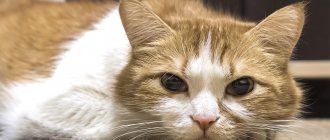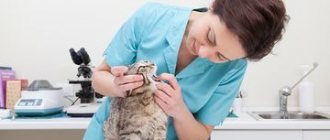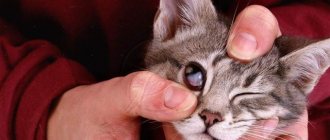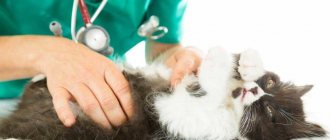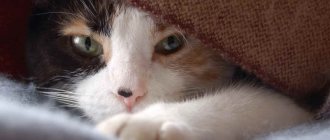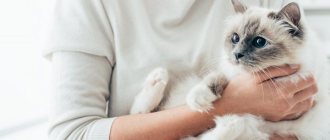4748Administration
Inversion of the eyelid in a cat is a pathology in which a fold of skin turns inside the eye. Because of this, the cornea is constantly traumatically affected by eyelashes and hair covering the eyelid. When an inversion of the lower eyelid occurs in a cat, with prolonged absence of treatment, the formation of a corneal ulcer is observed. As a result, the animal loses vision and experiences constant pain. The pet's quality of life is seriously deteriorated, and the cat cannot remain cheerful and cheerful when an entropion has occurred and the eyelid is in an unnatural position.
Why does the eyelid curl up?
In cats, entropion of the eyelids occurs for various reasons. The disease is caused by various factors, the main one of which is a genetic predisposition that causes a violation in the structure, as a result of which the eyelid curls up. This eye disease can occur in pets of any breed, but it most often affects the exotic Sphynx, as well as British and Persian cats.
© shutterstock
A cat's eyelids may droop for the following reasons::
- Spasm of the muscles of the orbit of the eye - from such an effect the eyelid experiences inversion;
- Incorrect development of the eyelids, as a congenital defect, when their length is excessive;
- An eye injury in which entropion occurs mechanically. Often injury occurs during play or a fight with another cat or dog;
- Foreign body in the eye - volvulus occurs due to mechanical damage;
- Scar formation - usually this phenomenon occurs if the cat's eyelid has been thermally or chemically burned and its edge is injured. When the damage heals, a scar appears, which causes volvulus;
- Previous unsuccessful surgical manipulations in the eye area, in which the cat did not undergo proper restorative therapy - the structure of the eyelid is disrupted and entropion occurs;
- Paralysis of the facial nerve - against the background of this pathology, the cat loses the ability to control the muscles of the eyelids, and they droop or roll up;
- Age-related degenerative processes in muscles and skin cause, among other things, entropion of the eyelid;
- Neoplasms in the eyelid area of a malignant or benign nature - with such a disease, the eyelid changes (to varying degrees) its shape, which can provoke volvulus.
The upper eyelid inversion is experienced much less frequently than the lower one. The disease has primary and secondary forms. The primary one appears in kittens due to improper development of the eyelids, and the secondary one appears in adult animals against the background of provoking factors associated with muscle dysfunction or injuries.
How can you tell if something is wrong with your cat's eye?
If there is something wrong with a cat's eye, it is easy to understand by its condition. The following symptoms will indicate the disease
- increased lacrimation and discharge of pus;
- redness of the mucous membrane and inflammation of the eyelids;
- photophobia, covering of the third eyelid and frequent blinking;
- pain on palpation;
- the appearance of itching;
- sticking of the eyelids after waking up due to the drying out of the accumulated exudate.
Depending on the cause of the malaise, symptoms may be supplemented by apathy, severe thirst and fever. If you notice at least a few of the listed signs, be sure to schedule your pet for an examination at a veterinary clinic.
Manifestations of the disease
If the owner knows the symptoms of the disease, then he will be able to identify bloat in the cat and provide timely assistance to the pet. First of all, when the eyelid rolls up, irritation of the cornea of the eye begins. Entropion of the eyelids is accompanied by other noticeable symptoms. Manifestations of the disease are presented in increasing order as it progresses :
- redness of the eyes;
- profuse lacrimation;
- swelling of the cornea of the eye;
- external reduction in eye size;
- change in the shape of the palpebral fissure due to the fact that the eyelid has rolled up;
- constant moisture in the fur around the eye;
- formation of a purulent mass in the corner of the eye;
- corneal ulcer;
- perforation of the eye.
At the last stage of the disease, a rolled eyelid causes such serious and irreversible changes in the cat's eye that it is impossible to save it. If you return the eyelid to the correct position in time, the problem will be completely eliminated.
© shutterstock
What signs can be used to suggest that a cat has entropion of the eyelids?
Entropion of the eyelids in cats
It is often unilateral in nature, but it can occur in both eyes at once.
Clinical signs are similar to those of entropion in dogs. With this pathology, we observe corneal syndrome, that is, a condition characteristic of irritation of the cornea: the eye is constantly or periodically squinted, and lacrimation is observed.
A veterinary ophthalmologist does not require complex tests to make a diagnosis. Entropion of the eyelids in cats is detected upon careful examination.
Often the skin of the eyelid or the fur wrapped inside rubs the cornea of the eye, which leads to the appearance of a corneal ulcer or keratitis.
In Persian cats, a common complication of entropion is corneal sequestration.
.
Maine Coon Leopard with entropion of the lower eyelid
Maine Coon Bars immediately after eyelid surgery
Maine Coon Bars after stitches removed
What breeds of cats have entropion of the eyelids?
Entropion of the eyelids
can occur in cats of any breed. But in our practice there has not been a single case of entropion of the eyelids in outbred cats.
Cat breeds in which entropion is most common
- U sphinxes
severe inversion of the eyelids is usually observed. In this case, both the lower and upper eyelids and the external commissure of the eyelids are tucked in. In addition, sphinxes often have eyeballs deeply set in the orbit, because of this the eyelids do not rest on the eye and the degree of entropion increases.
- U Maine Coons
When the eyelids are turned up, both the lower and upper eyelids can turn in. Moreover, the lower eyelid is usually turned up more. It can be mechanically turned into its normal position, but very soon it turns back again. Sometimes the lower eyelid is elongated and deformed.
- U Persians
and
exotics,
the inner part of the lower eyelid is usually wrapped. The more pronounced the skin nasolabial fold, the more pronounced the degree of inversion of the eyelids. - U British
and
the Scots
there is a standard version of eyelid inversion - the lower and upper eyelids turn in. - Less commonly, entropion of the eyelids occurs in other cat breeds, for example, Siamese
and
Thai
.
Diagnostics
The disease can be determined by a careful external examination. The animal's eyelid itself is directly noticeable, as well as swelling of the eye and purulent discharge.
Before surgical treatment, a complete examination is necessary. For this purpose, the animal is prescribed
- general blood analysis;
- biochemistry;
- Ultrasound of internal organs;
- Analysis of urine;
- ECG.
If all indicators are normal, then the cat will easily tolerate standard anesthesia, and the risk of complications will be minimal.
When a corneal ulcer occurs, after instillation of a fluorescent substance, the eye is examined using a slit lamp. If an infection of the eye is suspected, bacterial culture of the mucus and pus discharge on a nutrient medium is necessary to identify the pathogen and select antibiotics to which it is not resistant.
Treatment at home
After the diagnosis is made, the mustachioed patient must be provided with the most comfortable conditions possible. Place it in a darkened room, away from noise sources, other pets, children and other irritants.
To avoid further injuries, be sure to trim your cat’s claws and do not let him outside until he recovers. In addition to the basic treatment, which includes the use of eye drops and ointments, you will need to pay close attention to hygiene through rinsing.
Washing and hygiene
Washing is carried out using cotton pads, guided by the following algorithm
- Prepare all the necessary tools and preparations in advance to reduce the risk of traumatizing the animal with painful waiting.
- Wrap your pet in a thick cloth or find an assistant who can hold him during the procedure.
- Soak a cotton pad in the medicinal solution, squeeze it out and open the cat's eyelids.
- Gently move the disc over the eye, moving from the outer corner to the inner.
- Repeat the previous steps with the other eye, not forgetting to change the cotton pad.
The procedure can also be carried out using a syringe without a needle. To do this, you need to irrigate each eye with the solution under low pressure and gently blot them with a clean, lint-free cloth. After removing the accumulated dirt and soaking the crusts, you can begin applying the main preparation.
Drops and ointments
If something is wrong with a cat’s eye, then special drops and ointments will be required to normalize its condition. The list of necessary medications will depend on the cause of the disease:
- bacterial infection – Iris, Leopard, Levomycetin;
- viral infection – Anandin;
- fungal infection – Tetracycline;
- injuries - Traumeel.
The drops are instilled into both eyes at once, and the ointment is applied only to the disturbing area. After application, close the eyelids tightly and gently massage so that the product is evenly distributed inside. During treatment, it is recommended to wear an Elizabethan collar on your pet so that it does not inflict further injuries on itself when scratching.
Is it possible to use folk remedies?
Folk remedies can only be used as part of complex therapy. They do not fight the root cause, but only alleviate the patient’s condition by eliminating associated symptoms
It is also important to note that some herbs can cause an allergic reaction, so it is best to use them only under the supervision of a veterinarian.
Please note that the popular recipe with olive oil is extremely dangerous. Any oily substances create a very dense film
Because of this, new bacteria can quickly grow on the mucous membrane after treatment.
Features of treatment of pregnant, lactating and young individuals
Kittens, as well as pregnant and lactating animals, need gentler medications and lower dosages. Their immunity is weakened, so most antibiotics cause severe complications. Some of them can lead to miscarriages or stillbirths.
They also resort to surgery with extreme caution, since the anesthesia used can affect the course of pregnancy or the baby’s fragile heart. The indication for its implementation is a serious threat to life that exceeds the existing risks.
Treatment
The disease necessarily requires surgical intervention if it is not prohibited due to the general condition of the animal. If a sore eyelid is left untreated, the cat will not only go blind, but also lose an eye.
During therapy, one of two types of surgery can be performed. The first is the application of a temporary suture, and the second is eyelid surgery. The veterinarian will choose what kind of intervention the animal needs.
The first method is used in cats up to 7 months, when correction is possible due to the growth of the animal. To return the eyelid to a safe position, its lower edge is connected to the skin under the eye with a special mattress suture. The manipulation is simple and does not require anesthesia, which makes it much easier for the pet to tolerate.
© shutterstock
If the cat is older than 7 months, then the pathology can only be eliminated with eyelid surgery. This operation is performed under general anesthesia. During the intervention, a piece of excess skin is cut off, which is why the eyelid is curled inside the eye. The edges of the wound are then sutured, which returns the eyelids to their natural state.
Both types of surgery are performed only in the clinic.
How is entropion of the eyelids treated in cats?
There is only one way to treat entropion in cats - surgery - eyelid surgery.
A veterinarian ophthalmologist develops an operating plan individually for each patient. It depends on the type and degree of bloat. Similar cases are possible, but the same ones are never the same. The essence of the operation is the removal of excess skin and the application of a cosmetic suture. Everything is done so that the edges of the eyelids take the ideal, only correct position.
The operation is performed under general anesthesia. The animal must be kept on a starvation diet for 12-14 hours before surgery. Before the operation, the veterinarian carefully examines the animal. In some cases, before eyelid surgery in cats, clinical and biochemical blood tests and an ECG are performed.
Maine Coon Irkus with inversion of the eyelids and a rubbed corneal ulcer in the outer corner of the eye
Maine Coon Irkus immediately after eyelid surgery
Eyelid surgery was performed on 2 eyes
After eyelid surgery, tarsorrhaphy was performed on the left eye with an ulcer - temporary covering of the eye with the third eyelid
The same cat Irkus after 2 weeks - all stitches are removed, the corneal ulcer has healed
How do you care for a cat after eyelid surgery?
After surgery, the cat must wear a protective collar at all times until the stitches are removed.
On the first day after eyelid surgery, the sutures are treated 2 times a day, in subsequent days - 1 time a day with a 0.05% solution of chlorhexidine digluconate, and the crusts that have formed on the sutures are carefully removed. Then the seam is lubricated with a 40% alcohol solution.
If necessary, your veterinarian ophthalmologist will prescribe general antibiotics and certain eye drops and gels.
The sutures are removed by an ophthalmologist 12-14 days after surgery. At this time, the veterinarian can evaluate the outcome of the operation.
Is it necessary to treat entropion in cats?
We think so. Correcting entropion in cats is not just a cosmetic surgery. Eyelid surgery improves the cat’s quality of life, as the animal no longer suffers from pain in the eyes. In addition, entropion of the eyelids can lead to partial or complete loss of vision.
This operation is not performed for aesthetic reasons, but for medical reasons.
How to treat entropion in dogs >>
Veterinary assistance for the treatment of entropion in cats and dogs: +7 (499) 110-01-05
The difference between entropion in dogs >>
2007-2020: Network of Veterinary Clinics in Moscow “VASILYOK”:
What to do if you find an entropion of the eyelid?
You should not treat your pet on your own: the lack of appropriate therapy can lead to blindness and loss of an eye.
You should show the animal to a veterinarian or ophthalmologist as soon as possible. The doctor will conduct an additional examination of your vision. If a decision is made to treat the cat with surgery, eyelid surgery, urine and blood samples will need to be provided for laboratory testing. In addition, an ultrasound examination of the abdominal organs and an electrocardiogram are performed.
If complications occur, it will be necessary to further examine the condition of the cornea to detect ulcerative or other changes. In addition, if the bacterial nature of the pathological process is suspected, it will be necessary to conduct a bacterial culture in order to select suitable antibiotics.
Videos and illustrations
Inversion century Maine Coon cats. Entropion in a Maine Coon cat 2017
Entropion of the eyelids in a Maine Coon
Entropion of the eyelid in the Maycoon breed
Inversion of the lower eyelid and its plastic
Scheme of surgery for kittens using the mattress suture technique
Scheme of eyelid surgery
Main diseases and deviations in the health of sphinxes
As the kitten's head grows, the inversion of the eyelid resolves on its own.
This intervention is performed without anesthesia.
If the animal is older than 7 months, then eyelid surgery is used - in this case, a small piece of excess cat is cut off, and the remaining flaps are sewn together. In this way, the physiological position of the eyelashes and eyelid is achieved.
Features of preparation for surgery and postoperative care
12 hours before surgery, the animal is prohibited from giving food; water is allowed, but in small quantities. It is also advisable to conduct a full examination of the cat to determine the tolerability of general anesthesia and the operation itself.
Postoperative care is required for a week after the intervention. Be sure to put a collar on the cat to protect the seams and prevent scratching.
The wound itself is treated with antibacterial ointment - tetracycline or syntomycin, and local antibiotic therapy is also carried out - eye drops such as Iris or Tsiprolet are instilled into the conjunctival sac.
In case of a complicated course, it is also important to treat the complication.
If temporary sutures have been applied, no special care is required, but antibiotic drops should be instilled into the eyes.
Sutures for eyelid surgery are removed after 10 days in a veterinary clinic.
Why do my cat's eyes hurt?
The causes of the disease may be due to external factors, breed and predisposition to any ophthalmological disease. At any age, the disease requires treatment. Otherwise, the animal may become completely blind: cell decay and protein decomposition begin.
Possible causes of the disease
- Metabolic disease.
- Problems with intraocular fluid.
- Injuries, concussions, blows, bruises of varying degrees.
- Congenital pathology, if infectious diseases were transmitted to the kitten during birth.
- Old age. With age, metabolism slows down and the eye organ becomes less protected from external influences.
Extreme sports people and mixed breeds are most susceptible to eye diseases
Extreme sports people and mestizos are the most susceptible to diseases. Less commonly, eye pathology is observed in the “British” and “Scots”. Isolated cases occur in outbred cats. The main point, from the point of view of differentiating eye diseases, is the factors that determine the presence or absence of infection:
- Conditions of detention.
- Preventive measures.
- Stress levels matter most to cats.
- The presence of a source of the pathogen and its concentration in the environment.
- Concomitant diseases that cause predisposition to the infectious process.
Taking these factors into account, we can conclude that in inadequate conditions of detention in the absence of preventive measures, when the animal is in a stressful state, there are greater risks of eye infectious diseases.
Stress can cause eye problems in cats

